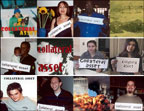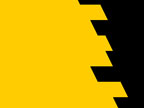:: Monday, July 26, 2004 ::

NEW WRITING: “Collateral Assets,” an interactive documentary web project by Deb King
BY: Molly Hankwitz
Deb King is a dedicated online artist and publisher, with a background in dance and performance art, that works out of Detroit, Michigan. She is one of the few who successfully develops online publishing as a community-building practice, and not just as an attribute of new technologies.
“Collateral Assets” started in the wake of the World Trade Centre disaster and bespeaks the possible effectiveness of internet art to communicate where other forms cannot. This work is high-concept and low-tech, utilizing email, digital photography, audio, and text to speak volumes about the political makeup of political identity. Moreover, it is a message about war, geography, and power.
The text begins: "These two past weeks have been a horror. Our vulnerability--the frailty of every life of all species on this planet--looms before us once again. Media bows to and embraces constant syntactic mutations, transforming human tragedy into nationalistic spectacle. We bow our heads. If this proposal offends or insults, my apologies ahead of time. I merely want to present a basic fact demonstrated so horrifically by the present world situation."
In a basic grid of sixteen images that blink on and off to the subtle rhythm of haunting, contemplative music, the interface greets you with a systematized portrait of dozens of ordinary people, each holding or standing near a handwritten sign of their own making, which reads “collateral assets”--a military term "used to indicate specific civilian populations," according to the project text.
The holding of descriptive text by individuals, photographed largely as snapshot portraits, evokes the many hopeful images of the missing people hung on fences and walls in lower Manhattan during 9/11. Yet, such semi-official or official-looking practical photography could be those used for police lineups or in the evening news, especially of the criminal or the victim, commonly
broadcast as the blurry faces of Middle-Eastern-looking terrorists or missing children.
Intermingled with these portraits of “collateral assets” are images from 9/11; images of the rubble, corpses, and war and its ever-present horror. Which war-induced disaster? Does it matter? They are photographs in living color. They are recent and we recognize them as such. We know so well the media; what war looks like; and whom it affects. The photo-grid beats like a heart to the audio. In a sidebar, you can read how to participate in seven languages and click on the links to find out how to add your own photo to the mix. When you proceed to this step, all sound abruptly stops. The audio and the pictured life form the piece in silence.
Web-based art can be audio-visually powerful. Yet that’s simply the manner in which this project is constructed -- a collection of images of people from all over the world (in their loss? in their pain?) he images are unified in a grid, collected by exchanging emails with the artist or uploading ready-made signs and images. This is the creative process; and by itself it speaks about global community, not as the hackneyed ideal-types of "cyberspace" but of a multicultural, mixed racial and multinational population.
The power of this piece is its accumulation across borders and boundaries. It is the power of internet communication to the work itself: The seeing of the normally unseen, yet the surprising strength of its "talked about" populations in cyber-arts culture. It demonstrates their absence in the discourse, while giving them a presence on screen. It's as if the all-too-white and anonymous signifiers of the net screen has opened upon another world entirely.
Is the message of the work, then, a contemplation on war? On war with its absence of human face? Its absence of certain populations, usually women, blacks, old, civilian from decision-making and from safety? From the destruction? Repetition of the phrase “collateral asset” reminds us of the phrase "collateral damage" that was used during the Persian Gulf War to refer to accidental civilian damage. As aftermath of the World Trade Center disaster and affiliations to previous battles, each with their own loss, their own history, “Collateral Assets” has power as a statement of documentary art; one with purpose and critical life-force.
click here to view Collateral Assets.
--------------------------------------
Deb King is a new-media artist who works in Detroit, Michigan. Her background is in dance, and she has spent over a decade as a performance artist, working in local galleries and street settings. Her current project is gender[f], an online event examining--through the works of women writers and artists--gender, racial, and economic biases resulting in systemic violence against women and minorities. It is set in a context of the 'war on terror' and is dedicated to the 400-plus women of Juarez that worked in the maquiladoras of Juarez who either disappeared or were murdered. Past projects have included: 'Rosemarie and Paul,' a three-act non-narrative based on a meeting of feminist disability scholar Rosemarie Garland Thomson and cultural theorist Paul Virilio. Online publications include 'Zehar' (Arteleku), 25 publishers discuss alternative publications, but only in Spanish; 'Past Tents Press' is a small poetry press she and a partner started in 1985.
Molly Hankwitz is a new-media writer and artist new to our netKru.

NEW WRITING: Targets (on CYCLOPS, a net art project by Conor McGarrigle)
BY: Isabel Saij
A plan, a labyrinth. Dedalus in Knossos, looking for an exit?
Bloom in a bar, Artie suffering among narrow minded and bigoted citizens.
Walk in a town, hundred years later.
Landmarks, reference points?
The rigid society of June of 1904 doesn’t give up today.
Dublin under tight surveillance. Network. Surveillance. Who’s on the watch?
We control with the sights of "big eye," don’t we?
A feeling of power as we look through the glass, behind the mirror,
and beyond it. Playful.
Four red zones on the map we’re looking at.
Four red places or districts: a topography, a topology.
Topos, logos, dialogue or monologue?
From these four points, four links, four ideas, convictions, mute requests,
or inner riots in front of the unacceptable.
Four associations: organ, art, color and style, chapter after chapter, in the book.
The Cyclopes, their muscles, the political topics, the green color, gigantism
as a literature technic, and Fenian as a symbol.
Artie, facing alone the Arthouse with its reflecting windows,
an art center and its screens, showing daily brutality... or being
a piece of the puzzle! Looking like a dancer in weightless conditions,
hidden behind a hood or a cowl, ready for a demo,
he calls on us all to witness.
What about life as a free citizen? What about rights to express
whatever we want or wish to change!
Portrait of an artist as a "scarecrow!"
What a fragility facing repression! Seeming to be absent,
he is spinning round and round, like a whirling dervish...
spreading his arms in a cross, being a target, a viewfinder, or a plus symbol?
Conversation. Artie in a talk with an "expert."
Is it a dialogue? is it a meeting? No, it’s not; nothing but a dialogue of the deaf,
a misuse of power, an unequal fight, a perpetual avoidance
from the one who knows, checks, decides, excludes, judges,
condemns, forgets but makes the trends, proud of himself,
servant of a system, acting with impunity, setting
the blade of the guillotine in action, cutting it short between
good and bad. Two soliloquies in a deep vanity, two actors
going their way here and there. Balloons pile up. Off!
The artist as a fool, needing critic to "sharpen his woolly thoughts!"
But our state thinks for us...produces, like a theocracy,
his temples, Aosdána’s artists belongs to the Gotha, then
to the Pantheon. 200 "heroes“ get the honor of being elected
for such a period of time, as life members... not so far away from the French academy,
where each academician, in a green suit, bearing a sword and a cocked hat,
is appointed for life!
So, be a "good" artist, wait for a place, and congratulations!
By the way, thank you for the "gun." I point out and shoot!
Got it! A chance to get a free place among these 200 "blessed best ones?"
I am joking; it’s a game.
Last zone: noting, following, and watching, the Cyclops’s eye
can supervise his herd of the anonymous, his registered citizens, and can save the dates,
in time and number, in black and white. In good and bad.
But what about the thoughts? Everyone’s thoughts?
What about the "woolly thoughts" behind these mute balloons?
Inner exile.
"The art would be better without artists," he said. A good, right thought!
Then, I guess that an artist should be a nobody!
Play us again?
Artie, like Ulysses, speaking to Fenian, the citizen, the Cyclops Polyphemus:
The stupid giant asking him "what’s your name?"
"nobody" could be the answer.
Break up the cameras, Artie!
"God’s sake! who committed this crime?"
"Nobody!"
click here to view Cyclops: A Dublin Story at http://www.stunned.org/

ORIGINAL POST: Saturday, July 17, 2000
BY: Peter Luining
In my ever continuing quest to find out more about net art as collectors’ objects, I found a new piece that can be added to the list of sold net-art pieces. Yesterday, Geert Lovink noted on nettime that Exonemo's netart piece Natural Process(NP) was bought by Google Inc. for $5000. In this case, though, I think that it's important to note that Exonemo's piece uses Google's image as a starting point, so a purchase by Google Inc. isn't that surprising. What I unfortunately don't know is if Google Inc. has an art collection or if this is a unique purchase; but what, of course, is clear is that they bought a net-art piece.
Also Interesting to note is that our own Garrett Lynch wrote a quite critical review of this piece some months ago. An older and extensive writing about sold net-art works can be found here: http://www.netartreview.net/ logs/ 2004_02_01_backlog.html. Check the entry for Tuesday, February 03, 2004.